The level of water within the human body is of the greatest importance, because if it falls below a certain level or accumulates to excess, that life-giving water can give rise to possibly fatal results. Do you know what the ideal amount of water in your body is? Moreover, are you able to determine the amount of water your body contains and take steps to maintain that ideal level? Of course not! Until you read this page, you may never even have considered that question. That is because your body contains an extraordinary self-governing system that flawlessly performs this important duty for you. The details of this system contain a number of astonishing miracles. Let us now examine it in some detail:
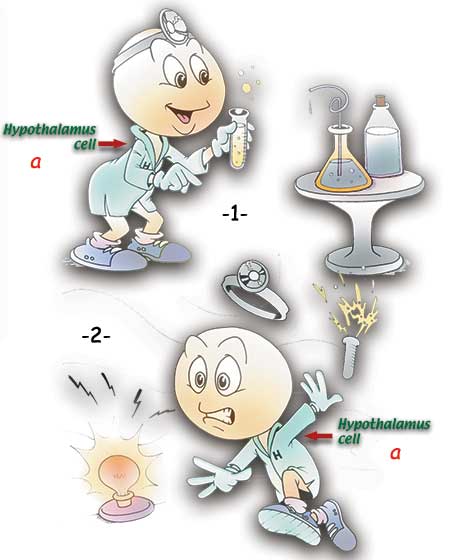 |
| Figure 1: Hypothalamus cells are responsible for measuring the amount of liquid in the blood. Figure 2: When the level of fluid in the blood falls below normal levels, the hypothalamus cells take the necessary precautionary measures and go into emergency mode. |
Yet the responsibilities of these tiny receptors go even further. If they determine that the level of fluid in the blood has dropped below the necessary level, they immediately take appropriate measures. This in itself is quite extraordinary. In addition, the receptors not only determine the fluid levels, but also know what their ideal level should be and when necessary, sound the alarm. (Figure 2.) The receptor, in a state of alert, immediately sends a message to the pituitary gland located at the rear of the brain. (Figure 3.)
At this point, various important questions need to be considered. How do these receptors know the location—and existence—of the pituitary gland? Moreover, how did they learn that help will be forthcoming from that gland in an emergency? No doubt that the answer to all these questions is the inspiration of our Almighty Lord. As with all the living things He has created, Almighty God, Lord of infinite might, inspires these receptors with the most perfect knowledge to fulfill their responsibilities.
 |
| a. hypothalamus cell |
| Figure 3: A hypothalamus cell in emergency mode immediately transmits a message to the pituitary gland at the back of the brain. |
As soon as the pituitary gland receives the message, it begins to release into the bloodstream greater amounts of the hormone vasopressin stored inside it. However, what kind of message does the pituitary gland receive? How is the pituitary gland able to understand a message from another organ and immediately go into action by evaluating it? These extraordinary miracles should be grounds for constant gratitude. (Figure 4.)
 |
| a. PG: Pituitary Gland |
| Figure 4: When the pituitary gland receives the message sent by the hypothalamus, it releases into the bloodstream a greater amount of the stored-up hormone vasopressin. |
The vasopressin hormone that the pituatary gland releases into the bloodstream is produced by cells in the hypothalamus. How did those hypothalamus cells learn the formulae for this hormone, which performs very important functions—as you shall soon see?
The formula for this hormone is encoded in the DNA. This, of course, is just one of the proofs of Almighty God's miraculous creation. You should also remember that there are codes belonging to the hormone vasopressin in the DNA in the nuclei of every cell in your human body. However, neither your liver cells, nor your stomach cells nor your muscle cells ever use this code—only those in the hypothalamus, which produce the vasopressin. How has this division of labor been established? What prevents other cells from using this code?
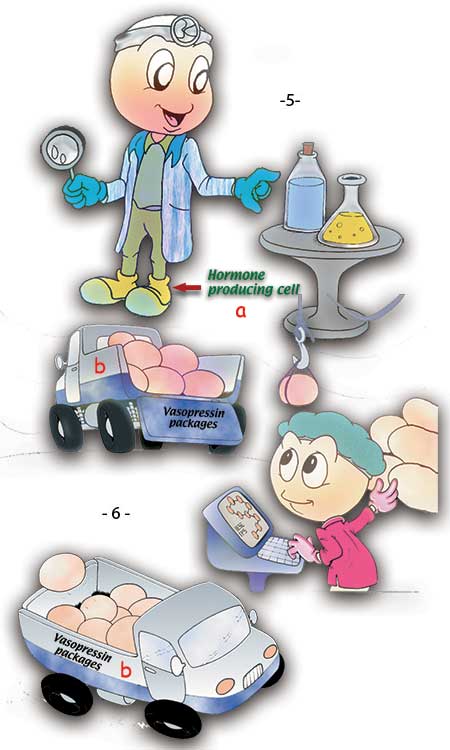 |
| Figure 5: After its manufacture, the hormone vasopressin is packaged inside another protein. Figure 6: The packaged vasopressin is transferred to the pituitary gland and stored there, to be used when the time comes. |
The marvels concerning vasopressin are by no means limited to these. Once the vasopressin has been manufactured, it is transferred to the pituitary gland by being packaged inside another protein, and stored there until the time comes for it to be used. Tiny structures within the cell, too small to be visible without a microscope, work like different units in a factory, organized along the most finely detailed lines. (Figures 5 through-7.)
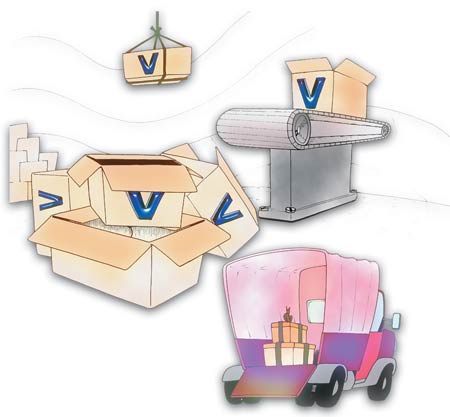 |
| Figure 7: As soon as the pituitary gland learns that the level of fluid in the blood has declined, it releases the stored hormone vasopressin into the bloodstream, where it is forwarded to the kidneys. |
After the message arrives, vasopressin is released into the bloodstream from the pituitary gland and immediately reaches the kidney (Figure 8). After vasopressin sets out from the pituitary gland in the brain until it arrives at the kidney, it passes by a great many organs. Yet as if this hormone knew where it was going, by what route and what its purpose was, it reaches the kidney without getting lost or stopping at any other organ. How does it receive the command to head straight to the kidney, and how can the unconscious molecules in question understand the message and duly find their way there?
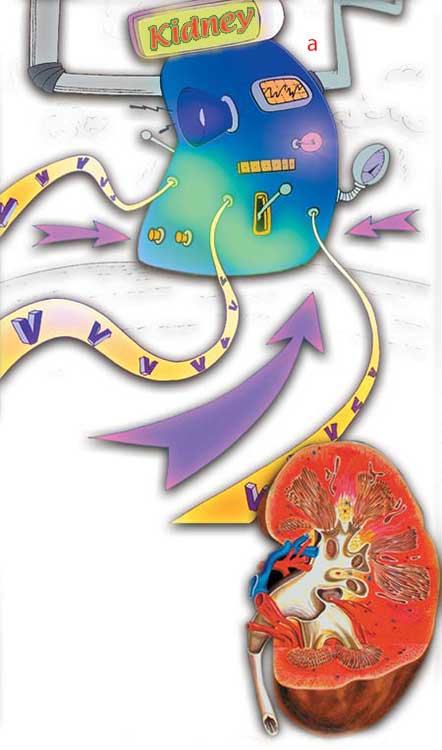 |
| a. Kidney |
| Figure 8: Once released into the bloodstream from the pituitary gland, the vasopressin soon reaches the kidneys. A cross-section of the kidney can be seen on the right. |
The vasopressin hormone reaches the kidney by locking onto receivers around the millions of micro-channels in that organ. These receptors have been specially created for vasopressin, and the two fit one another like a key and a lock. (Figure 9.) How is this compatibility established? Anyone could find it difficult to come up with two miniaturized shapes that match each other so exactly, unless biochemistry is specialty and the profession of the individual concerned. Yet there are many other similar examples of this in the body. Moreover, both the hormone vasopressin and the chemical receptors in the kidneys are constructed by cells in completely different areas of the body. Nonetheless, the result is a flawless compatibility. This is an example of our Lord's mercy for His servants.
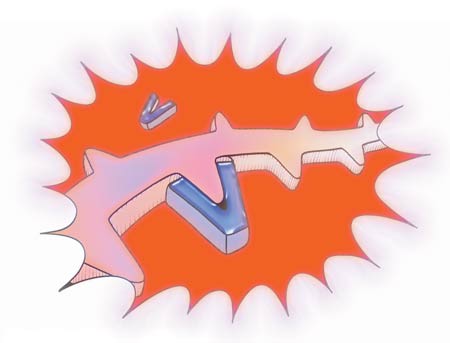 |
| Figure 9: The vasopressin reaching the kidneys bonds to receptors around millions of micro-channels inside them. These receptors have been specially created for vasopressin, so that they fit one another like a key and a lock. |
By means of this bonding, the kidney is given the command to withdraw the water molecules from the urine. Thanks to this communication system, a large portion of the water molecules are separated out and introduced back into the bloodstream. As a result, the amount of urine is reduced, and the body re-acquires water it would otherwise have lost.
But if a person has drunk excessive liquids, then the mechanism works in the exactly reverse direction. When the density of water in the blood becomes elevated, the receptors in the hypothalamus slow down the secretion of vasopressin (Figure 10). As the amount of vasopressin decreases, the volume of urine increases accordingly, and the level of water in the blood is returned to normal, healthy levels.
This flawless system is just a single example of the sophisticated systems operating throughout the body. And even this brief description is sufficient to show that nothing takes place haphazardly, but that all things, at all times, are under the control of Omniscient and Almighty God.
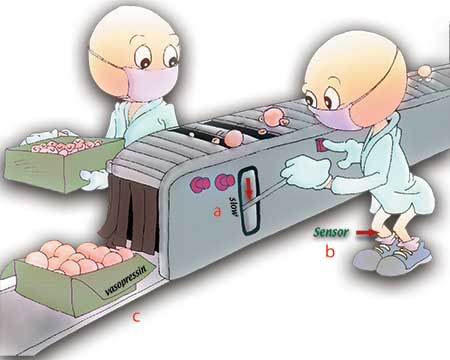 |
| a. slow, |
| Figure 10: When the concentration of water rises in the blood, sensors in the hypothalamus slow the release of the hormone vasopressin. |